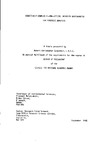INDUCTIVELY COUPLED PLASMA-OPTICAL EMISSION SPECTROMETRY FOR FORENSIC ANALYSIS
| dc.contributor.author | Carpenter, Robert Christopher | |
| dc.contributor.other | School of Geography, Earth and Environmental Sciences | en_US |
| dc.date.accessioned | 2013-11-13T11:41:02Z | |
| dc.date.available | 2013-11-13T11:41:02Z | |
| dc.date.issued | 1985 | |
| dc.identifier | NOT AVAILABLE | en_US |
| dc.identifier.uri | http://hdl.handle.net/10026.1/2680 | |
| dc.description.abstract |
The fundamental characteristics and applications of inductively coupled plasma - optical emission spectrometry (ICP-OES) for forensic science purposes have been evaluated. Optimisation of ICP-OES for single elements using simplex techniques identified an ICP torch fitted with a wide bore injector tube as most suitable for multielement analysis because of a compact analytical region in the plasma. A suitable objective function has been proposed for multielement simplex optimisation of ICP-OES and its effectiveness has been demonstrated. The effects of easily ionisable element (EIE) interferences have been studied and an interference minimisation simplex optimisation shown to be appropriate for the location of an interference free zone. Routine, interference free determinations (<2% for 0.5% Na) have been shown to be critically dependant on the stability of the injector gas flowrate and nebuliser derived pressure pulses. Discrete nebulisation has been investigated for the analysis of small fragments of a variety of metal alloys which could be encountered in casework investigations. External contamination together with alloy inhomogeneity have been shown to present some problems in the interpretation of the data. A compact, corrosion resistant recirculating nebuliser has been constructed and evaluated for the analysis of small fragments of shotgun steels. The stable aerosol production from this nebuliser allowed a set of element lines, free from iron interferences, to be monitored with a scanning monochromator. The analysis, classification and discrimination of casework sized fragments of brasses and sheet glasses have been performed and a method has been proposed for the analysis of white household gloss paints. The determination of metal traces on hands following the handling of a variety of metal alloys has been reported. The significance of the results from these evidential materials has been assessed for forensic science purposes. | en_US |
| dc.language.iso | en | en_US |
| dc.publisher | University of Plymouth | en_US |
| dc.title | INDUCTIVELY COUPLED PLASMA-OPTICAL EMISSION SPECTROMETRY FOR FORENSIC ANALYSIS | en_US |
| dc.type | Thesis | |
| plymouth.version | Full version | en_US |
| dc.identifier.doi | http://dx.doi.org/10.24382/4250 | |
| dc.identifier.doi | http://dx.doi.org/10.24382/4250 |
Files in this item
This item appears in the following Collection(s)
-
01 Research Theses Main Collection
Research Theses Main


